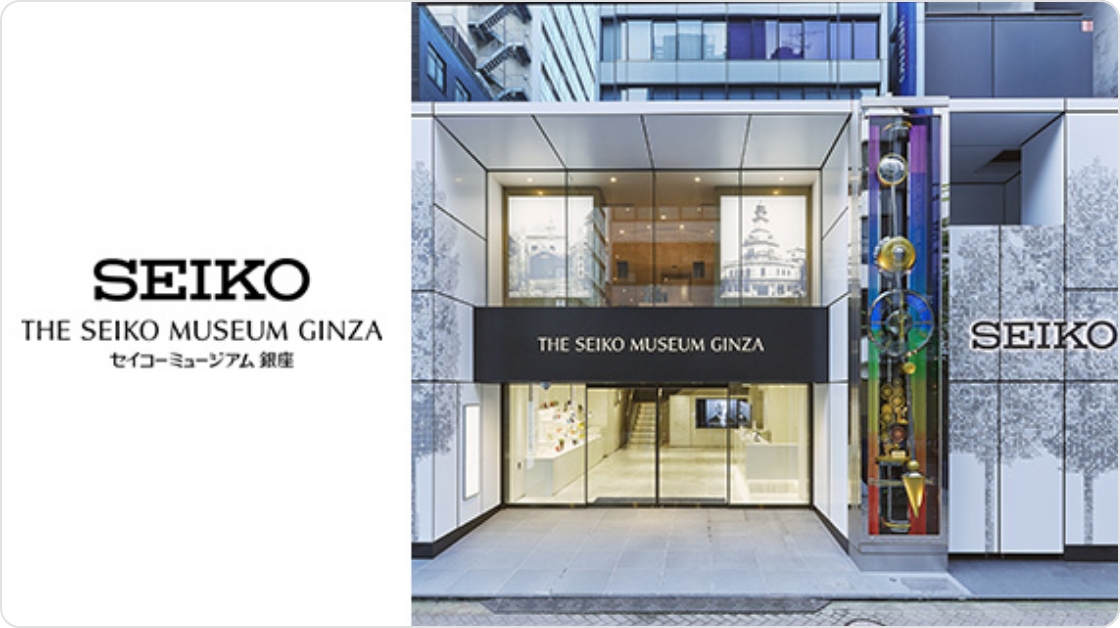1800s —
-
1881
Kintaro Hattori establishes the K. Hattori (watch and clock retail and repair store).
Earning the trust of foreign trading companies, the business expands greatly. -
1890
Commencement of direct import of timepieces from America.
-
1892
Building on the success of the retail business, Seikosha is established and commences manufacturing of wall clocks.
-
1894
The company moves to the corner of Ginza 4-chome and builds a store with a clock tower.
-
1895
Manufacturing of the company's first pocket watch, the Timekeeper, commences.
By persisting in the pocket watch business, despite continuing losses, the company eventually corners the market. -
1899
The company begins manufacturing alarm clocks.
1900s —
-
1905
Distributors established in Shanghai and Hong Kong.
-
1909
The company develops its own automatic pinion lathe, dramatically improve manufacturing efficiency of pocket watches.
The pocket watch business becomes profitable the following year. -
1913
Anticipating a shift away from pocket watches, the company launches Japan's first wristwatch, the Laurel.
-
1915
The company receives large orders for a total of 900,000 alarm clocks from the UK and France.
-
1917
Established K. Hattori & Co., Ltd. with a capital stock of 5 million yen, reorganizing as a company organization.
-
1923
Despite losing all its factories and stores to the Great Kanto Earthquake in September, the company recommences operations in November. The company replaces all watches that were held for repair and destroyed in the disaster with brand new watches free of charge, thereby gaining the firm trust of the public.
-
1924
Launch of the first Seiko brand watch.
-
1929
The Seikosha pocket watch is designated as the first Japan-made railway watch.
1930s —
-
1930
Production of Japan's first camera shutters.
-
1932
Completion of the current clock tower on Ginza 4-chome (SEIKO HOUSE).
-
1934
Death of Kintaro Hattori.
-
1937
Spun off the Watch Division of Seikosha clock factory and established an independent organization as Daini Seikosha Co., Ltd. (currently Seiko Instruments Inc.)
-
1942
Daiwa Kogyo, Ltd. established as a cooperative company of Daini Seikosha (later becoming a joint venture company).
-
1947
Retail division separates to become Wako Co., Ltd.
-
1949
Listed on the Tokyo Stock Exchange.
-
1953
Broadcasting of Japan's first television commercial.
-
1956
Launching of the independently-designed Marvel watch.
-
1959
The Suwa factory becomes independent and forms Suwa Seikosha Co., Ltd. (now Seiko Epson Corporation).
Quartz clock provided to Chubu-Nippon Broadcasting for announcing the time. -
1960
Launching of the Grand Seiko, achieving the world's highest standard in accuracy.
-
1964
Launching of the Crystal Chronometer, a portable quartz clock.
-
Official timer of the Tokyo Olympics.
Seiko later serves as official timer of 5 other Olympic Games (Sapporo, Barcelona, Lillehammer, Nagano, Salt Lake City). -
1965
Launching of the first Japan-made diver's watch.
-
1967
Seiko is awarded 2nd and 3rd places in the mechanical watch corporate awards at the Neuchâtel Observatory Competition.
-
1968
Seiko takes the top ranking for mechanical watches at the Geneva Observatory Competition.
-
Launching of the first Japan-made desktop computer.
-
Launching of the world's first quartz wall clock for home use.
-
Hattori (H.K.) Ltd. (currently Seiko Hong Kong Ltd) is established in Hong Kong, after which local corporations are established in succession around the world.
-
1969
Launching of the Quartz Astron, the world's first quartz watch.
-
Launching of the 5 Sports Speedtimer 6139, the world's first automatic chronograph with a vertical clutch and column wheel at the same time.
1970s —
-
1970
Installation of the world's first radio wave clock at the Osaka Expo.
-
Seiko Time Corporation (currently Grand Seiko Corporation of America and Seiko Watch of America) is established in America.
-
Established Seikosha Co., Ltd. by splitting off the Seikosha clock factory
-
Developed a quartz watch equipped with the world’s first CMOS IC
-
1971
Kiyoko Nakayama* becomes the first female Contemporary Master Craftsman.
Since then, there have been 26 employees designated as Contemporary Master Craftsmen.
*Of Suwa Seikosha Co., Ltd. (now Seiko Epson Corp.) -
Seiko Time Corporation Toronto established in Canada.
Seiko Time (U.K.), Ltd. established in the UK. -
1972
Seiko Time GmbH established in Germany.
-
Seiko serves as official timer of the Sapporo Olympics.
-
1973
Launching of the world's first 6-digit LCD watch.
-
1974
Seiko Time Ltd. Brazil established in Brazil.
-
1975
Launching of the first Japan-made plastic optical lenses.
Launching of the Professional Diver 600, the first Japan-made saturation diver's watch. -
Development of quartz crystal, silver oxide batteries.
-
1977
Kazuo Takeoka wins the WorldSkills Competition.
Since then, there have been 7 employees winning this competition.
*Of Suwa Seikosha Co., Ltd. (now Seiko Epson Corp.) -
Seiko Time (Panama) S.A. established in Panama.
-
1978
Masahide Nakazawa wins the national watch repairing contest.
Since then, there have been 8 employees winning this competition.
*Of Suwa Seikosha Co., Ltd. (now Seiko Epson Corp.) -
1979
Seiko Time Pty. Ltd. established in Australia.
-
1981
Opening of the Seiko Institute of Horology (now the Seiko Museum).
-
1982
Launching of the world's first TV watch.
-
Entry into the small thermal printer business.
-
1983
Changes the name to Hattori Seiko Co., Ltd.
-
Launching of Pyramid Talk, the talking clock.
-
1984
Installation of the Mullion Clock, Japan's first large-scale marionette clock, sparking a national boom in marionette clocks.
-
1985
Launching of the automated ordering system for the restaurant industry.
-
1986
Launching of crystal oscillator module ICs.
-
CHG established in France (now Seiko France).
-
1987
Seiko serves as official timer of the IAAF World Championships in Athletics in Rome.
Thereafter, Seiko continues to serve as official timer of the World Athletics Championships. -
1988
Launching of the world's first automatic quartz watch Kinetic.
-
Established SEIKOSHA (THAILAND) CO., LTD. (currently SEIKO Precision (Thailand) Co., Ltd.) in Thailand.
-
1989
Launch of ultra-thin, ultra-precise wall clocks.
1990s —
-
1991
Manthon Seiko established in Thailand (now Seiko Thailand).
-
Seiko serves as official timer of the IAAF World Championships in Athletics in Tokyo.
-
1992
Seiko serves as official timer of the Barcelona Olympics.
-
1993
Seiko Time Systems Inc.(now Seiko Time Creation Inc.)established.
-
Seiko serves as official timer of the IAAF World Championships in Athletics in Stuttgart.
-
1994
Seiko serves as official timer of the Lillehammer Olympics.
-
1995
Seiko serves as official timer of the IAAF World Championships in Athletics in Gothenburg.
-
1996
Established SEIKO Clock Inc. and SEIKO Precision Inc. Each of them succeeded businesses from Seikosha Co., Ltd in March in the same year.
-
Established Seiko Optical Products Co., Ltd. to spin off the Eyeglasses Business.
-
1997
Changed the name to Seiko Corporation.
-
Seiko serves as official timer of the IAAF World Championships in Athletics in Athens.
-
1998
Seiko serves as official timer of the Nagano Olympics.
-
1999
A replica of the movement of the world’s first quartz wristwatch, Seiko Quartz Astron was exhibited at the Smithsonian Museum in Washington, D.C., U.S.
-
Launching of the world's first Spring Drive watch.
-
Commencement of CREPiCO, Japan's first wireless credit card payment service.
-
Seiko serves as official timer of the IAAF World Championships in Athletics in Seville.
2000s —
-
2001
Established SEIKO WATCH CORPORATION to spin off the Watches Business and the Company became a holding company.
-
Seiko serves as official timer of the IAAF World Championships in Athletics in Edmonton.
-
2002
Seiko serves as official timer of the Salt Lake City Olympics.
-
Commencement of time stamp service
-
2003
Seiko serves as official timer of the IAAF World Championships in Athletics in Saint-Denis.
-
2004
Opening of the Shizukuishi Watch Studio, a fully-integrated manufacturing facility for mechanical watches.
-
Seiko Quartz Astron, the world’s first quartz watch, recognized as an IEEE Milestone by the IEEE (Institute of Electrical and Electronics Engineers).
-
2005
Development of mercury-free silver oxide batteries.
-
Mamoru Sakurada is awarded the Medal with Yellow Ribbon for watch assembly.
Since then, there have been 9 employees awarded the Medal with Yellow Ribbon. -
Seiko NPC Corporation established.
-
Seiko serves as official timer of the IAAF World Championships in Athletics in Helsinki.
-
Launch of Yukyu, a clock recreating the world’s oldest escapement mechanism.
-
2006
The world's first e-ink display watch is launched and wins in the electronic watch category at the Grand Prix d'Horlogerie de Genève.
-
2007
Seiko serves as official timer of the 1st Tokyo Marathon, and continues to serve as official timer thereafter.
-
Changed the name to SEIKO HOLDINGS CORPORATION.
-
Seiko serves as official timer of the IAAF World Championships in Athletics in Osaka.
-
2009
Business merger with Seiko Instruments Inc.
2010s —
-
2010
Spring Drive Spacewalk wins in the “sports watch” category at the Grand Prix d'Horlogerie de Genève.
-
2011
Seiko serves as official timer of the 1st Osaka Marathon, and continues to serve as official timer thereafter.
-
Seiko serves as official timer of the IAAF World Championships in Athletics in Daegu.
-
2012
Launching of the Seiko Astron, the world's first GPS solar watch.
-
2013
Seiko Solutions Inc. established.
-
Seiko serves as official timer of the IAAF World Championships in Athletics in Moscow.
-
Launching of the Seiko Space Link, the world's first* satellite radio wave clock for home use.
* In the genre of analog display wall clocks with an integrated GPS receiver powered by dry-cell batteries (based on our research) -
2014
Grand Seiko’s Mechanical Hi-Beat 36000 GMT Limited Edition won the Petite Aiguille prize at the 2014 Grand
Prix d’Horlogerie de Genève. -
2015
Satoshi Hiraga is designated as a Contemporary Master Craftsman.
Yoshifusa Nakazawa* is awarded the Medal with Yellow Ribbon.
*Of Seiko Epson Corp. -
Seiko serves as official timer of the IAAF World Championships in Athletics in Beijing.
-
2016
Nobuhiro Kosugi is awarded the first Medal with Yellow Ribbon for watch design.
-
2017
Seiko serves as official timer of the IAAF World Championships in Athletics in London.
-
Ayana Hiraya* wins the national watch repairing contest.
*Of Seiko Epson Corp. -
Made Grand Seiko an independent brand
-
Launch of an ultra-compact, ultra-lightweight mobile printer for business use, the MP-B20.
-
2018
Seiko Prospex 1968 Diver’s Re-creation won the Sports Watch Prize at the 2018 Grand Prix d’Horlogerie de Genève.
-
2019
IAAF World Championships in Doha Contributing to the success of the first World Championships held in the Middle East with the latest timing systems
-
Launch of the world’s first reflowable MS Lithium Rechargeable Battery.
-
Launch of LUiNa, an AI-based prediction system.
-
Seiko Prospex LX Line Diver’s won the Diver’s Watch Prize at the 2019 Grand Prix d’Horlogerie de Genève.
2020s —
-
2020
Newly established Grand Seiko Studio Shizukuishi in a manufacturing site of Morioka Seiko Instruments Inc.
-
Relocated the Seiko Museum to Ginza and opened as the "Seiko Museum Ginza"
-
2021
SEIKO Clock, Inc. and SEIKO Time Systems, Inc. were merged to form a new company, SEIKO Time Creation, Inc.
-
The Grand Seiko Hi-Beat 36000 80 Hours powered by Caliber 9SA5, SLGH005, won the Men’s Watch Prize at the 2021 Grand Prix d’Horlogerie de Genève.
-
2022
Launch of Grand Seiko Kodo, a watch incorporating the world’s first truly new timekeeping mechanism.
-
Transferred to the Prime Market from the First Section of the Tokyo Stock Exchange due to the restructuring of its market segments.
-
Changed the name of WAKO Main Building to SEIKO HOUSE.
-
Changed the name to SEIKO GROUP CORPORATION.
-
Grand Seiko Kodo Constant-force Tourbillon SLGT003 won the Chronometry Prize at the 2022 Grand Prixd’Horlogerie de Genève.
-
2024
The "Grand Seiko Museum" opened at the Seiko Museum Ginza.
-
Seiko launched the next-generation development initiative "Toki-iku" after surpassing 10,000 participants.
Related information




